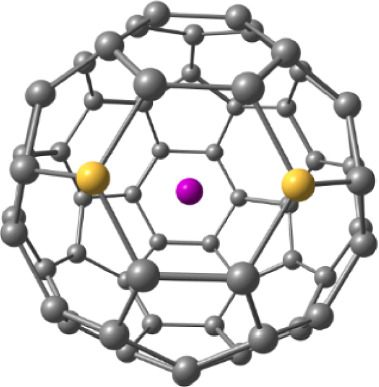https://doi.org/10.1140/epjd/s10053-025-00958-3
Regular Article – Clusters and Nanostructures
Iodine, tellurium, and xenon inside fullerene: modeling of endohedral structures
1
St.Petersburg State University, St. Petersburg, Russia
2
Petersburg Nuclear Physics Institute of National Research Center “Kurchatov Institute”, Gatchina, Russia
Received:
30
October
2024
Accepted:
13
January
2025
Published online:
20
May
2025
The structural parameters, spin states, quadrupole or dipole moments, embedding energies, and IR spectra of endohedral I−@C60, I−@C60+, I–@C58B2, I−@[C58B2]+, I−@[C59B]+, I−@[C60I]+, (I−@C60+)2, Te@C60, Te@C58B2, Xe@C60, and Xe@C58B2 complexes are predicted by quantum chemical DFT (U)PBE0 method. The nucleus of an endo-atom is localized in the vicinity of cage center. The distortion of the fullerene structure by the endo-atom is small. The electrically neutral complexes are metastable. The energies of I−@C60 and I−@C58B2 anions are lower than the sum of the energies of free components. The addition of the iodine exo-atom to the I−@C60+ free radical transforms it into the stable singlet I−@[C60I]+ zwitter-ion, the energy of which is lower than the energy of the molecule C60I2. The relaxation effect after β− decay of the radioiodide endo-anion in the fullerene cage is very small. The possibilities of synthesis of fullerene and heterofullerene endohedral complexes with radioactive iodine from a tellurium-containing precursor are discussed.
Supplementary Information The online version contains supplementary material available at https://doi.org/10.1140/epjd/s10053-025-00958-3.
Copyright comment Springer Nature or its licensor (e.g. a society or other partner) holds exclusive rights to this article under a publishing agreement with the author(s) or other rightsholder(s); author self-archiving of the accepted manuscript version of this article is solely governed by the terms of such publishing agreement and applicable law.
© The Author(s), under exclusive licence to EDP Sciences, SIF and Springer-Verlag GmbH Germany, part of Springer Nature 2025
Springer Nature or its licensor (e.g. a society or other partner) holds exclusive rights to this article under a publishing agreement with the author(s) or other rightsholder(s); author self-archiving of the accepted manuscript version of this article is solely governed by the terms of such publishing agreement and applicable law.





